Mindfulness exercises provide effective strategies for reducing anxiety, enhancing concentration, and building emotional resilience. These practices promote relaxation and emotional regulation while training the mind to focus on the present moment. Regular engagement can lead to lower stress hormone levels, improved attention spans, and better management of emotional responses. Tailored techniques and innovative approaches further enhance their effectiveness across diverse populations and settings.

How do mindfulness exercises reduce anxiety?
Mindfulness exercises effectively reduce anxiety by promoting relaxation and enhancing emotional regulation. These practices, such as meditation and deep breathing, help individuals focus on the present moment, which diminishes anxious thoughts. Research indicates that regular mindfulness practice can lower cortisol levels, a key stress hormone. Additionally, mindfulness enhances concentration and emotional resilience, allowing individuals to respond to stressors more effectively. Engaging in these exercises consistently can lead to long-term improvements in mental well-being.
What are the physiological effects of mindfulness on anxiety?
Mindfulness exercises significantly reduce anxiety by promoting relaxation and enhancing emotional regulation. These practices activate the parasympathetic nervous system, leading to decreased heart rate and lower cortisol levels. Research shows that regular mindfulness can improve focus and resilience, helping individuals manage anxiety more effectively. For example, a study indicated that participants practicing mindfulness reported a 30% reduction in anxiety symptoms over eight weeks.
Which mindfulness techniques are most effective for anxiety relief?
Mindfulness techniques such as deep breathing, body scanning, and mindful meditation are effective for anxiety relief. These practices promote relaxation and enhance emotional resilience.
Deep breathing exercises help regulate the nervous system, reducing anxiety symptoms. Body scanning encourages awareness of physical sensations, fostering acceptance. Mindful meditation improves concentration and emotional regulation, offering long-term benefits for anxiety management.
Research indicates that regular practice of these techniques can significantly lower anxiety levels, making them valuable tools for mental health.
How does mindfulness impact the brain’s response to stress?
Mindfulness significantly reduces the brain’s stress response by promoting emotional regulation and resilience. Studies show that mindfulness exercises enhance the prefrontal cortex’s function, improving focus and reducing anxiety. Regular practice leads to structural changes in the brain, such as increased gray matter density in regions associated with emotional regulation. As a result, individuals experience lower levels of cortisol, the stress hormone, contributing to overall well-being.
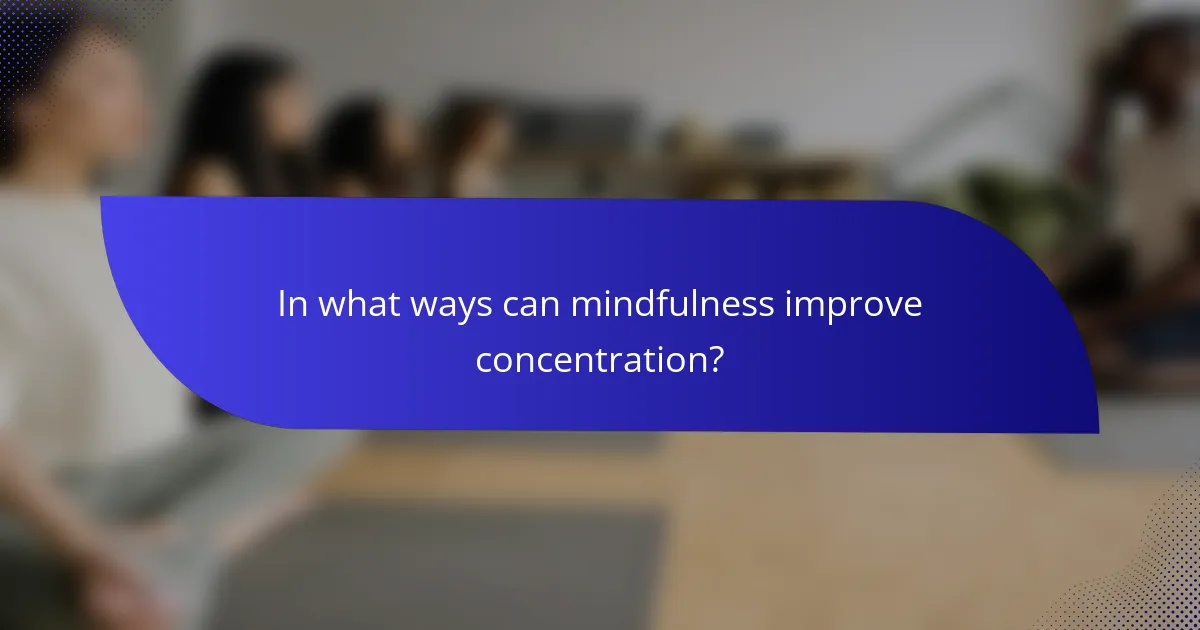
In what ways can mindfulness improve concentration?
Mindfulness significantly enhances concentration by training the mind to focus on the present moment. This practice reduces distractions and promotes mental clarity, allowing individuals to engage more deeply with tasks. Research indicates that regular mindfulness exercises can improve attention span and cognitive flexibility. For example, studies show that participants who practice mindfulness report higher levels of concentration and lower levels of anxiety. This dual benefit contributes to improved performance in various activities, from studying to professional tasks.
What role does mindfulness play in enhancing focus and attention?
Mindfulness significantly enhances focus and attention by training the mind to remain present. It reduces distractions and promotes emotional resilience, allowing individuals to concentrate better on tasks. Regular mindfulness exercises, such as meditation and deep breathing, can lead to improved cognitive performance and reduced anxiety levels. Research shows that consistent practice can increase gray matter density in brain regions associated with attention and sensory processing.
How can mindfulness exercises be integrated into daily routines for better concentration?
Mindfulness exercises can be seamlessly integrated into daily routines to enhance concentration. Start by dedicating a few minutes each morning for focused breathing. Incorporate mindful moments during daily activities, such as eating or walking, to cultivate awareness. Utilize reminders, like phone alerts, to prompt short mindfulness breaks throughout the day. Consistent practice fosters emotional resilience, reduces anxiety, and ultimately improves overall concentration.
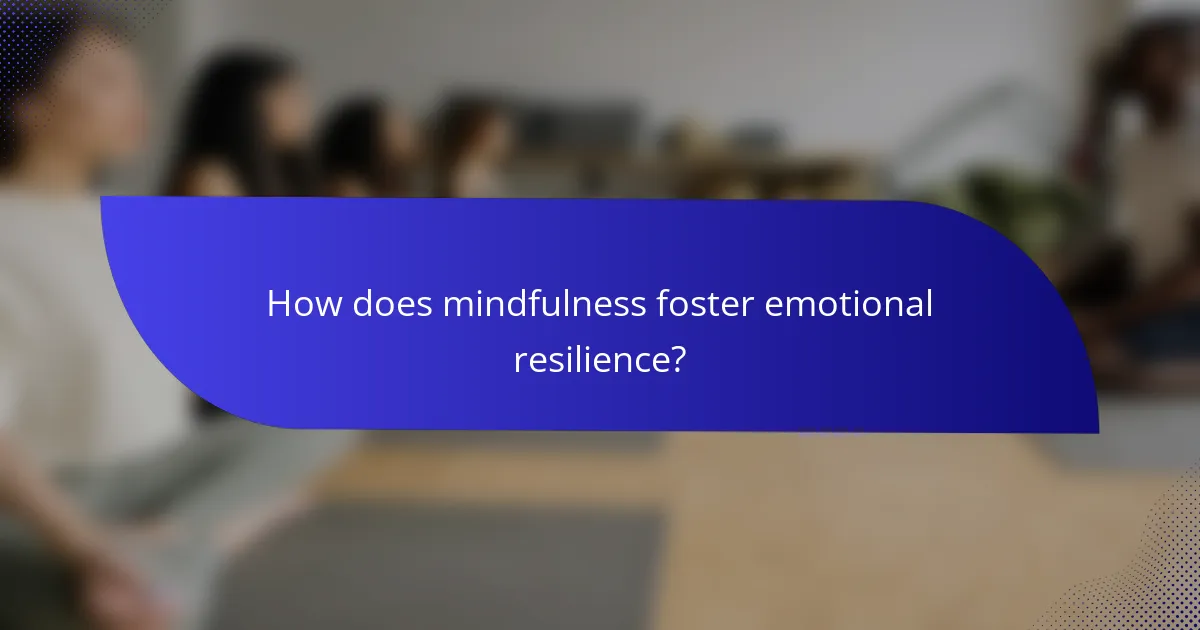
How does mindfulness foster emotional resilience?
Mindfulness fosters emotional resilience by enhancing self-awareness and promoting emotional regulation. Regular mindfulness exercises, such as meditation and deep breathing, reduce anxiety and improve concentration. These practices help individuals recognize their emotional responses, allowing for better management of stress and adversity. As a result, mindfulness builds a stronger foundation for coping with life’s challenges.
Which mindfulness practices are linked to increased emotional strength?
Mindfulness practices linked to increased emotional strength include meditation, deep breathing, and body scanning. These exercises enhance emotional resilience by promoting self-awareness and reducing anxiety. Regular practice leads to improved concentration and better emotional regulation. For example, mindfulness meditation can increase emotional intelligence, helping individuals respond to stress more effectively.
What is the relationship between mindfulness and emotional regulation?
Mindfulness enhances emotional regulation by promoting awareness and acceptance of emotions. This practice reduces anxiety, improves concentration, and builds emotional resilience. Mindfulness exercises, such as meditation and deep breathing, help individuals observe their thoughts without judgment. As a result, they can respond to emotional stimuli more effectively, fostering a balanced emotional state. Research shows that regular mindfulness practice can lead to increased gray matter density in brain regions associated with emotional regulation, indicating its profound impact on mental health.
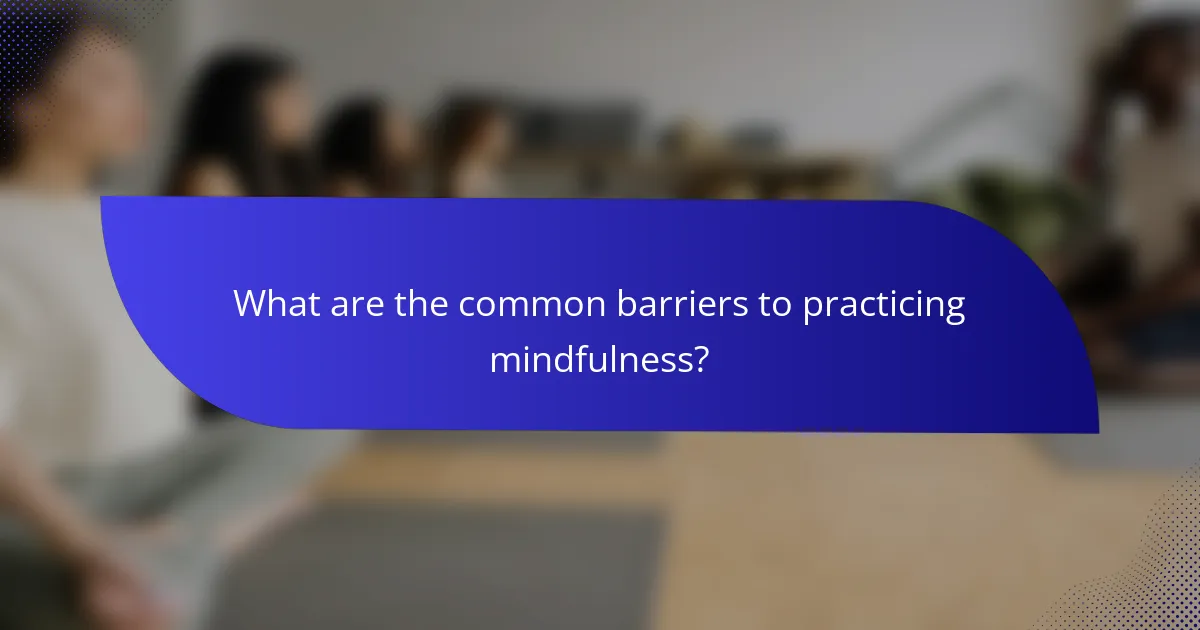
What are the common barriers to practicing mindfulness?
Common barriers to practicing mindfulness include time constraints, difficulty focusing, and negative self-talk. Many individuals struggle to find dedicated time for mindfulness exercises, which can hinder consistency. Additionally, distractions and racing thoughts may disrupt concentration during practice. Negative self-talk can lead to frustration and discourage continued efforts. These barriers can reduce the effectiveness of mindfulness for anxiety reduction, concentration, and emotional resilience.
How can individuals overcome obstacles to regular mindfulness practice?
Individuals can overcome obstacles to regular mindfulness practice by establishing a consistent routine, creating a supportive environment, and using guided exercises. Consistency helps reinforce the habit, while a dedicated space minimizes distractions. Guided exercises can enhance focus and provide structure. Additionally, setting realistic goals and tracking progress can boost motivation. Engaging in mindfulness with a community or partner may also increase accountability and enjoyment.
What misconceptions about mindfulness might hinder its effectiveness?
Misconceptions about mindfulness can significantly undermine its effectiveness. Many believe mindfulness requires a completely empty mind, which is unrealistic. Others think it is merely a relaxation technique, overlooking its potential for enhancing emotional resilience and concentration. Some may assume that mindfulness is a quick fix for anxiety, neglecting the need for consistent practice. Additionally, there is a misconception that mindfulness is only for certain individuals, when in fact, it can benefit anyone seeking mental clarity and emotional balance. Understanding these misconceptions is crucial for maximizing the benefits of mindfulness exercises.

Which mindfulness exercises are tailored for specific populations?
Mindfulness exercises tailored for specific populations include techniques like guided imagery for individuals with anxiety, breath awareness for students needing concentration, and loving-kindness meditation for enhancing emotional resilience. These exercises address unique needs and promote mental well-being effectively.
For example, guided imagery helps reduce anxiety by creating calming mental images. Breath awareness improves focus by centering attention on the breath. Loving-kindness meditation fosters emotional resilience by encouraging positive feelings towards oneself and others. Each exercise is designed to support the mental health of its target population.
How can mindfulness be adapted for children and adolescents?
Mindfulness can be effectively adapted for children and adolescents through age-appropriate exercises. Techniques such as guided imagery, breathing exercises, and body scans help reduce anxiety and enhance concentration.
Incorporating playful elements engages younger audiences. For example, using storytelling or games can make mindfulness more relatable. Short sessions of 5-10 minutes are ideal for maintaining attention.
Practicing mindfulness in group settings fosters social skills and emotional resilience. Peer support encourages sharing experiences, which reinforces learning.
Regular practice can lead to significant improvements in emotional regulation and stress management. Studies show that mindfulness can reduce anxiety levels by up to 30% in adolescents.
What mindfulness strategies are beneficial for healthcare professionals?
Mindfulness strategies beneficial for healthcare professionals include deep breathing, body scans, and mindful observation. These exercises enhance anxiety reduction, concentration, and emotional resilience. Deep breathing helps regulate stress responses, while body scans promote awareness of physical sensations. Mindful observation encourages focused attention on the present moment, reducing distractions. Regular practice of these techniques can lead to improved mental well-being and better patient care outcomes.
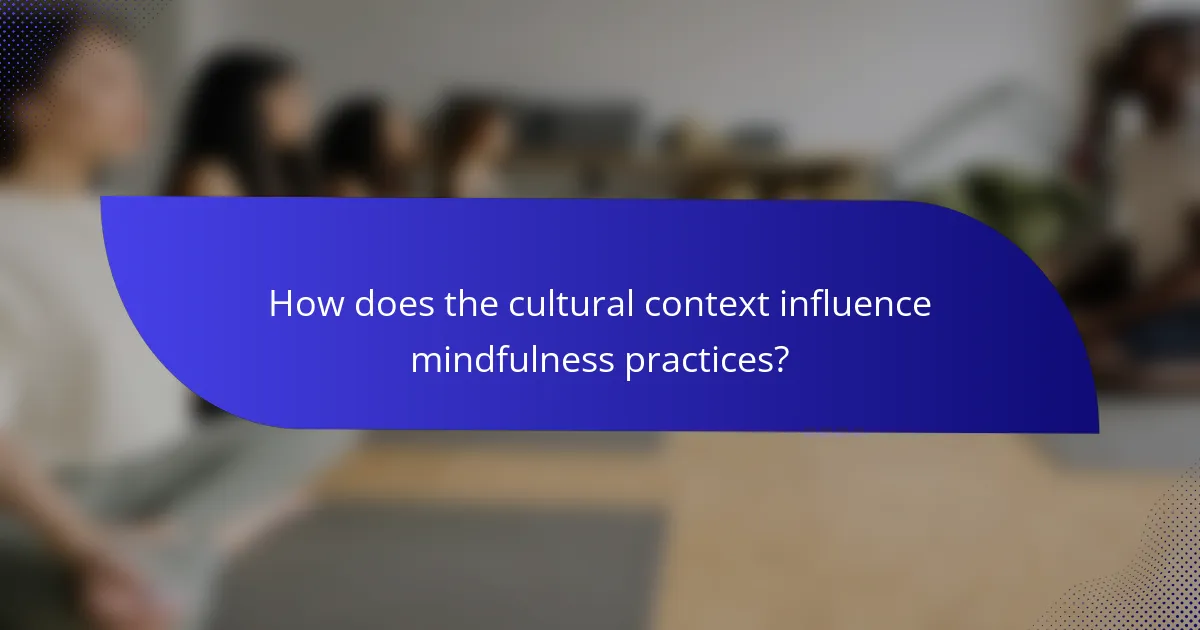
How does the cultural context influence mindfulness practices?
Cultural context significantly shapes mindfulness practices by influencing their techniques and applications. Different cultures emphasize various aspects of mindfulness, such as community engagement or individual introspection. For instance, Eastern traditions often integrate mindfulness with spirituality, while Western approaches may focus on psychological benefits. These cultural nuances affect how mindfulness exercises are designed for anxiety reduction, concentration, and emotional resilience. Furthermore, the acceptance and adaptation of mindfulness in diverse settings can enhance its effectiveness, making it more relatable and practical for individuals across different backgrounds.
What variations of mindfulness exercises exist across different cultures?
Mindfulness exercises vary widely across cultures, each offering unique approaches to anxiety reduction, concentration, and emotional resilience.
In Buddhism, practices such as sitting meditation and walking meditation focus on breath awareness and present-moment observation. In contrast, Japanese Zen emphasizes zazen, a seated meditation that cultivates deep stillness and insight.
Yoga, rooted in Indian traditions, combines physical postures, breath control, and meditation to enhance mental clarity and emotional balance. Similarly, Tai Chi from China integrates slow, mindful movements with breath awareness for stress relief and focus.
Indigenous cultures often incorporate nature-based mindfulness, using rituals and storytelling to foster connection with the environment and self-awareness.
These diverse practices highlight the adaptability of mindfulness across various cultural contexts, each contributing to emotional well-being and resilience.
How do local perceptions of mindfulness affect its adoption?
Local perceptions of mindfulness significantly influence its adoption rates. Cultural beliefs and societal norms shape how individuals view mindfulness practices. In communities where mindfulness is regarded positively, participation in exercises for anxiety reduction, concentration, and emotional resilience tends to be higher. Conversely, negative perceptions can hinder engagement, limiting access to the benefits of these practices. Research indicates that when mindfulness is integrated into local health initiatives, acceptance increases, fostering a supportive environment for individuals seeking emotional resilience.
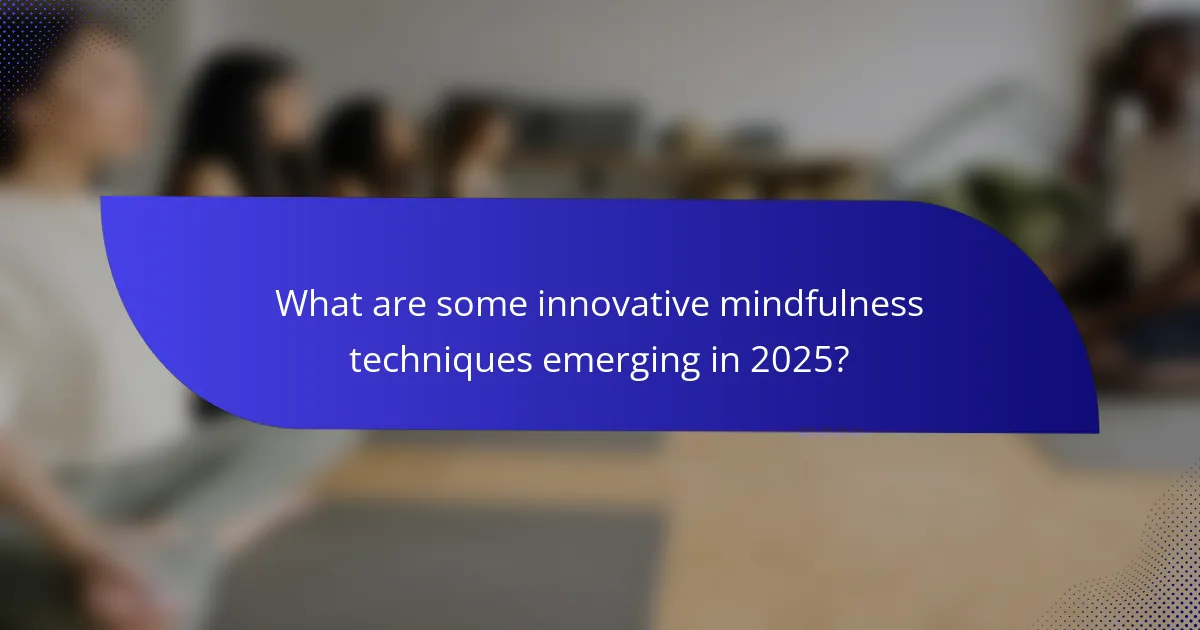
What are some innovative mindfulness techniques emerging in 2025?
Innovative mindfulness techniques emerging in 2025 focus on immersive experiences and technology integration. Virtual reality mindfulness sessions enhance anxiety reduction by creating calming environments. Biofeedback devices monitor physiological responses, aiding concentration and emotional resilience. Interactive apps use AI to personalize mindfulness practices, adapting to individual needs. Group mindfulness activities leverage social connections, fostering community support and enhancing emotional well-being.
How is technology shaping the future of mindfulness exercises?
Technology is transforming mindfulness exercises by enhancing accessibility and personalization. Mobile apps and virtual platforms allow users to engage in mindfulness practices anytime. Advanced algorithms tailor exercises to individual needs, promoting anxiety reduction, concentration, and emotional resilience. For example, biofeedback devices provide real-time data, helping users understand their physiological responses during mindfulness sessions. This integration of technology fosters greater engagement and effectiveness in mindfulness practices.
What research is being conducted on new mindfulness methodologies?
Research is exploring innovative mindfulness methodologies that enhance anxiety reduction, concentration, and emotional resilience. Studies are investigating techniques such as integrative body-mind practices, digital mindfulness apps, and community-based mindfulness programs. These methodologies aim to improve mental health outcomes by incorporating neurobiological insights and personalized approaches. Recent findings suggest that combining mindfulness with cognitive behavioral strategies significantly boosts emotional regulation and focus.
What expert tips can enhance the effectiveness of mindfulness practices?
To enhance the effectiveness of mindfulness practices, focus on consistency, environment, and technique. Regular practice solidifies benefits for anxiety reduction, concentration, and emotional resilience.
1. Set a specific time daily for mindfulness exercises to build a habit.
2. Choose a quiet, comfortable space free from distractions to enhance focus.
3. Experiment with different techniques like breathing exercises or guided meditations to find what resonates best.
4. Incorporate short mindfulness breaks throughout the day to maintain emotional balance.
5. Use mindfulness apps for structure and variety in your practice.
6. Reflect on your experiences to deepen your understanding of personal progress.